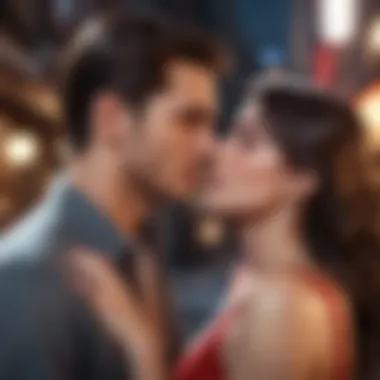Essential Romance Comics Every Enthusiast Should Read


Intro
Romance comics have a distinct place in the world of graphic storytelling. Their ability to blend emotional depth with engaging narratives allows them to resonate with readers across various demographics. While other genres have their merits, romance comics stand out due to their focus on interpersonal relationships, emotional conflict, and the often tumultuous nature of love. This article delves into essential romance comics that every enthusiast should explore. We will cover key themes, influential creators, and memorable works, ensuring readers can appreciate the medium's evolution and richness.
Overview of Comic Books
Latest Updates and News
The landscape of romance comics has changed drastically in recent years. New creators are stepping up, bringing fresh perspectives and innovative storytelling methods. Platforms like Webtoon and Tapas have gained popularity, offering romance comics that appeal to younger audiences. Notable titles such as "Lore Olympus" have sparked interest in digital comics, showcasing how traditional themes of romance evolve in modern contexts.
Trends and Popularity
Romance comics are gaining traction in the mainstream comic market. Readers are looking for diverse storylines that explore different cultural backgrounds and LGBTQ+ representation. Today, the focus on complex character development and realistic portrayals of relationships enhances readership engagement. Moreover, the blur of genres has become more pronounced. Romance now frequently intersects with fantasy, science fiction, and horror, providing layered narratives that intrigue readers.
Releases and Announcements
Several key titles have been announced for upcoming release, reflecting the genre's expanding horizons. Groundbreaking works include projects by established authors as well as debut graphic novels from rising creators. Fans can anticipate an increase in anthology collections featuring diverse stories, allowing for broader representation and exploration of various romance sub-genres.
In-Depth Analysis
Plot Summary and Analysis
To appreciate romance comics fully, one must recognize the depth of their storytelling. For instance, in "Saga" by Brian K. Vaughan and Fiona Staples, the romance between Alana and Marko is intricately interwoven with sci-fi elements, producing a narrative that is both compelling and relatable. Each plot point serves to enhance themes of love, sacrifice, and the complexity of relationships.
Character Development
Creating relatable characters is essential in romance comics. Readers must connect with the protagonists on a personal level. Characters like those in "Fruits Basket" by Natsuki Takaya exemplify this, as their emotional journeys address personal flaws and growth within the context of love and relationships.
Storyline and Artwork
Artwork significantly enhances the emotional weight of romance comics. The illustrations in "Love & Rockets" by Los Bros Hernandez blend stunning visuals with deep storytelling, creating a vivid portrayal of relationships. The unique styles help convey the characters' emotions, making the narrative much more compelling.
Behind the Scenes
Development Process for Comic Books
The creation of romance comics involves multiple stages. Starting from idea conception to final artwork, collaboration among writers, artists, and colorists is crucial. Each stage adds a layer of creativity that influences the final product. Notably, the involvement of editors plays a vital role in guiding the narrative toward a polished form.
Production Insights
Understanding the production insights can deepen the appreciation of romance comics. Independent publishers often showcase more diverse themes and stories than mainstream publications. This has led to a surge in small presses focusing on inclusive narratives. The passion that creators pour into their work becomes evident through the final product.
Reviews and Recommendations
Critic Reviews and Ratings
Many romance comics have received critical acclaim. "Heartstopper" by Alice Oseman has been praised for its representations of queer love. Critics commend its nuanced approach to young love, earning high ratings across various review platforms.
Recommendation Lists
Here are some essential titles for every enthusiast to explore:
- "Saga" by Brian K. Vaughan and Fiona Staples
- "Fruits Basket" by Natsuki Takaya
- "Lore Olympus" by Rachel Smythe
- "Heartstopper" by Alice Oseman
- "Love & Rockets" by Los Bros Hernandez
These comics represent a plethora of styles and narratives and offer insights into the ever-evolving romance genre. By engaging with these works, readers can deepen their appreciation for romance comics and their cinematic counterparts.
Studying romance comics enhances understanding of character dynamics and emotional storytelling, allowing for a more profound engagement with this unique medium.
Preamble to Romance Comics
Romance comics hold a unique place in the world of graphic storytelling. They combine visual art with narratives that delve deeply into human emotions and relationships. This section provides a broad understanding of what romance comics represent and why they are crucial for readers and creators alike. Through romance comics, themes of love, heartbreak, and intimacy are explored with both authenticity and depth.
Definition and Scope
Romance comics are defined as comic books or graphic novels that primarily focus on romantic relationships. They encapsulate various plotlines, from light-hearted tales of young love to more serious examinations of complex emotional issues. The scope of romance comics encompasses not only traditional heterosexual romances but also LGBTQ+ relationships, providing a diverse array of stories that reflect real-world dynamics. Understanding the definition and scope of romance comics allows readers to appreciate the versatility and richness of the genre.
Appeal of Romance Comics


The appeal of romance comics lies in their ability to resonate with readers on a personal level. They often explore themes that are universally relatable, such as desire, vulnerability, and conflict in relationships. These comics serve as a mirror reflecting readers’ own experiences or aspirations, creating a sense of connection that is hard to find in other genres. Additionally, the visual medium can enhance emotional engagement through character expressions and artistic styles. Some key factors that contribute to the appeal include:
- Emotional Depth: Romance comics often delve into the psychology of relationships, offering genuine explorations of love and its complications.
- Relatable Situations: Many readers can identify with the scenarios depicted, making the stories resonate even further.
- Diversity of Representation: Modern romance comics showcase a wide spectrum of love stories, enabling more readers to see themselves within the narratives.
History of Romance Comics
The exploration of romance comics has significant value for anyone aiming to understand the evolution of storytelling in the medium. This section examines the rich past that has shaped romance comics into the form we know today. By recognizing the historical context, readers can appreciate the cultural shifts and artistic innovations that defined various eras within this genre. The narrative of romance comics intertwines with societal changes, reflecting the hopes, dreams, and challenges encountered by people throughout time.
Early Innovations
The origins of romance comics can be traced back to the 1940s and 1950s, a time when the comic book industry began to diversify beyond superheroes. Early innovators such as Joe Simon and Jack Kirby introduced stories that appealed directly to young women. These comics often revolved around relatable experiences, such as love, heartbreak, and the complexities of relationships. Titles like Young Romance debuted in 1947, and it sparked a new wave in the genre.
These early attempts to capture the emotional dimension of personal relationships laid the groundwork for what would become a beloved genre. The art style in these early comics also adapted to represent the changing ideals of beauty and romance in society. Writers and illustrators collaborated to craft stories that resonated deeply with their audience, focusing on emotional narratives rather than merely plot-driven action.
Key Milestones
As romance comics matured, several key milestones marked their trajectory and relevance in popular culture. The introduction of Forever People in the late 1960s represented a shift towards more progressive themes, as it incorporated contemporary issues into romantic plots. This comic began to challenge traditional gender roles, a reflection of the broader feminist movements taking place at that time.
The rise of graphic novels in the late 1980s also transformed the genre. Works like Roz Chast’s comics brought a new depth to romance, presenting complex characters and multifaceted relationships. Each decade saw changes, resulting in a diverse array of stories.
"Romance comics have not only entertained but also sparked conversations about societal norms, consistently evolving to meet the spirit of the times."
By the 21st century, romance comics became more inclusive. Diverse stories about different sexualities and identities began to emerge, attracting new readerships. Indie comics, such as those published by Image Comics and Dynamite Entertainment, further diversified the landscape. Just as significant is the rise of digital comics, allowing greater access to creators and readers alike. Today, romance comics continue to evolve, reflecting contemporary experiences while staying true to their roots.
In summary, the history of romance comics provides essential insights into the development of the genre. Understanding its past not only enhances appreciation of the comics but also offers a greater context for evaluating current works and emerging trends.
Notable Authors and Artists
In the realm of romance comics, the creators behind the narratives play an integral role in shaping not only the stories but also the emotions and connections that readers experience. Notable authors and artists contribute unique perspectives and expertise, influencing the genre in ways that resonate with audiences. Their creativity and distinct styles often define the characteristics of the works they produce.
The importance of recognizing these figures extends beyond mere appreciation. Understanding their contributions provides valuable insight into the evolution of romance comics. It allows readers to explore different storytelling techniques and thematic explorations that have shaped the genre over time. Additionally, highlighting these creators promotes further exploration of their other works, enriching the reading experience.
Influential Figures in Romance Comics
Romance comics have been shaped by a multitude of influential writers and artists. Among them, Misty Lee and Diane Dwyer stand out for their pioneering narratives that challenge traditional norms.
- Misty Lee: Known for her evocative writing and character-driven stories, Misty Lee merged emotional depth with compelling plots, engaging readers on multiple levels. Her ability to weave intricate relationships into the fabric of her stories has left a lasting impact on the genre.
- Diane Dwyer: Equally impressive, Diane Dwyer is recognized for her unique illustration style that adds layers of visual storytelling to her narratives. Her work often emphasizes the emotional subtleties of human connections, drawing readers into the hearts of her characters.
These authors are just a tip of the iceberg. Many more have contributed significantly to the landscape of romance comics. Their works often touch upon complex themes, reflecting the societal changes during their respective eras.
Emerging Voices to Watch
While the giants of romance comics shaped the past, the genre continues to evolve with emerging voices bringing fresh perspectives. Some new authors and artists are making waves in the industry, pushing boundaries with innovative ideas.
- Sara Rodriguez: A fresh talent, Sara explores themes of identity and love in a modern context. Her stories resonate with young readers seeking relatable narratives.
- Gabi Martinez: Gabi's unique blend of humor and sincerity offers a new perspective in romance comics. Her work demonstrates that romance can be both lighthearted and deeply touching.
These emerging creators represent a shift towards inclusivity in storytelling, inviting diverse voices and experiences into the fold. As romance comics continue to grow, keeping an eye on these artists will reveal the future direction of the genre.
Genres within Romance Comics
Understanding the various genres within romance comics is essential for any enthusiast or novice. Each genre offers unique perspectives, themes, and styles that resonate differently with readers. By exploring these genres, a reader can find narratives that align closely with their preferences, enhancing the overall experience. Moreover, the diversity found in romance comics helps ensure that no two stories feel alike, making each exploration into the genre fulfilling and enriching. This section highlights three prominent genres: contemporary romance, historical romance, and fantasy and speculative romance.
Contemporary Romance
Contemporary romance comics capture the nuances of modern relationships, often reflecting current societal issues and trends. The characters in these comics tend to be relatable, showcasing familiar settings, dilemmas, and emotions. For instance, comics may tackle subjects like online dating, friendships, and the complexities of love in a fast-paced world.
One notable title in this genre is "Siren's Song" by Kelsey Diem. This comic addresses self-discovery and modern dating dynamics, illustrating how these elements shape contemporary relationships. Readers are often drawn to contemporary romance because it mirrors their own experiences and aspirations, making it easy to connect with the characters emotionally.
Historical Romance
Historical romance comics transport readers to different eras, exploring how love and relationships were perceived in those times. They often fuse accurate historical details with romantic narratives, creating immersive experiences. This genre allows readers to witness how social norms, culture, and the passage of time influence human connections.
A popular example is "The Duchess's Dilemma" by Annabelle Hart. This comic artfully portrays the challenges faced by lovers from different social strata during the Victorian era. By reading historical romance comics, one gains a better understanding of how love operates across diverse contexts and how it evolves over time.
Fantasy and Speculative Romance
Fantasy and speculative romance comics venture into realms beyond reality, merging love stories with elements of magic, mythology, or futuristic settings. These narratives can stretch the boundaries of traditional romance, allowing for imaginative plots that engage the reader's sense of wonder. Such genres often explore themes like the quest for belonging, challenges against societal norms, and the power of love in overcoming odds.


A standout in this category is "Wings of Fate" by Liora Mist. This comic weaves a tale where star-crossed lovers exist in an enchanted world filled with fantastical creatures. The allure of fantasy and speculative romance lies in its ability to provide escapism while simultaneously presenting profound truths about love and connection.
Comics are not merely a form of entertainment but a medium for reflection and understanding of complex emotions.
Must-Read Romance Comics
The realm of romance comics is diverse and engaging, drawing in readers from various backgrounds and interests. The section on must-read romance comics is crucial as it acts as a guiding light for enthusiasts who wish to delve deeper into this genre. Featuring a careful selection of titles that highlight the breadth and depth of romance comics, this list showcases how the genre has evolved and its cultural significance.
These recommendations not only serve as entry points for newcomers but also offer layered narratives that can resonate with seasoned fans. They provide reflections on human emotions, relationships, and societal norms, making them a valuable part of any comic book collection. Each title included in this section stands out due to its unique artistry, storytelling, and emotional impact, ensuring that readers can find something that resonates with their tastes.
Classic Titles
Classic titles in romance comics often serve as foundational texts within the genre, shaping the expectations and standards for future works. One such title is "Love and Romance," a series that captured the essence of romantic relationships in the mid-20th century. This series not only influenced countless creators but also depicted societal attitudes toward love and relationships at the time.
Another noteworthy classic is "Young Love," which presented relatable stories of young romance fraught with the challenges of adolescence. This comic's legacy remains strong as it is often credited with encapsulating the tumultuous emotions of youth and its various manifestations of love.
Modern Favorites
As the genre has advanced into the 21st century, modern favorites have emerged that resonate with contemporary audiences. Titles like "Saga" by Brian K. Vaughan and Fiona Staples blend sci-fi elements with profound romantic relationships, engaging readers with complex characters and intricate plots.
Another favorite is "Heartstopper" by Alice Oseman, which has gained significant traction online. Its portrayal of LGBTQ+ romance is both tender and nuanced, offering a fresh perspective that speaks to younger audiences grappling with their identities and relationships. These modern titles not only entertain but also spark important conversations about love, identity, and inclusivity.
Indie Gems
Indie comics have increasingly found their voice in the romance genre, offering diverse stories that challenge traditional narratives. "Delilah Dirk and the Turkish Lieutenant" by Tony Cliff stands out for its unique blend of romance, adventure, and strong female characters. The playful yet sincere approach to love and relationships offers an engaging reading experience.
Similarly, "Mooncakes" by Suzanne Walker and Wendy Xu combines fantasy elements with coming-of-age themes, creating a story rich in emotional depth and representation. These indie gems showcase that romance comics can come in various forms and styles, broadening the horizons of what the genre can offer.
Overall, the realm of romance comics is not just about love stories; it encompasses cultural reflections and innovative storytelling.
Recognizing the importance of classic titles, modern favorites, and indie gems allows readers to appreciate the wide range of narratives available within the romance comic genre. Each selected work holds significance and contributes to a greater understanding of romance in storytelling.
Understanding Themes and Motifs
Understanding the themes and motifs within romance comics is essential for fully appreciating this genre. Themes such as love, heartbreak, personal growth, and cultural reflection are often explored deeply. Romance comics are not only about romantic interactions; they also provide insight into societal values and individual behaviors. By examining these elements, readers can gain a richer perspective on stories and characters, identifying with their experiences and emotions.
Love and Relationships
The theme of love is central to romance comics. Various aspects of love are explored in different ways. These comics portray the emotional highs and lows of relationships. Readers witness characters navigate the complexities of falling in love, dealing with heartbreak, and searching for connection. This theme is particularly compelling because it mirrors real-life experiences. For many readers, these stories provide solace or reflection on their own lives.
For example, in titles like "Saga" by Brian K. Vaughan and Fiona Staples, love exists in fantastical settings but still resonates due to its authenticity. The characters face challenges that test their bond, showcasing that love is not just an ideal but a journey filled with trials.
Additionally, the complexities of relationships are portrayed with nuance. The comics examine various dynamics—romantic, familial, and platonic. Readers might see how friendship can evolve into something more, or how love can be strained by external pressures. Such representations highlight the multifaceted nature of human connections.
Cultural Reflections
Cultural reflection is another critical aspect of romance comics. These works often encapsulate social norms, gender roles, and cultural expectations. By doing so, they create a dialogue between the fictional world and the real world. Readers can explore how romance is shaped by culture, influencing individual choices and societal perceptions.
For instance, comics like "Love and Rockets" by the Hernandez brothers delve into Latino culture, showcasing characters that reflect diverse backgrounds and experiences. Through these narratives, readers gain a greater understanding of the cultural factors that influence romance.
Moreover, romance comics can challenge stereotypes and push for more inclusive representations. By highlighting marginalized voices, they contribute to a broader understanding of love and relationships across different cultures. This encourages readers to reflect on their own beliefs and prejudices.
The Role of Illustration in Romance Comics
The visual representation in romance comics is crucial, playing a significant role in conveying emotions and plot developments. Unlike traditional literature, where the reader relies solely on text, romance comics combine narrative with visual art to create a unique storytelling experience. Illustrations can enhance the emotional weight of a story, making it more relatable and engaging for readers. This fusion of art and narrative captures attention and helps in portraying complex emotions effectively.
In romance comics, illustrations are not just supplementary but integral to the overal storytelling. The choice of art style can set the tone for the narrative. Different artistic approaches, from realism to stylized graphics, can evoke distinct emotional responses. Readers often respond to characters based on their visual representation, which heightens their investment in the story.
Art Styles Explained
Various art styles find their home within romance comics, each offering a unique perspective on themes of love and relationships. These styles range from illustrative sketches to vibrant, detailed illustrations. For instance, a more whimsical art style can signify light-hearted romance, while a realistic approach may convey deeper emotional struggles.
Some common art styles include:
- Manga-inspired: A style strong in dialogue and character expressions, popular among younger audiences.
- Classic American: Often characterized by bold lines and vibrant colors, making it visually striking.
- Indie styles: These can vary widely, often reflecting the personal vision and emotional state of the artist.
Selecting a particular style often aligns with the narrative’s mood and intended audience. Hence, illustrations function as a dual layer of storytelling.


Artist Techniques and Impact
The techniques used by artists in romance comics greatly affect how the story is perceived. Variations in line work, coloring techniques, and shading can create mood and atmosphere. For example, softer lines and pastel colors might be employed to depict delicate emotions, while harsher lines and darker colors may convey conflict and intensity.
Consider some impactful techniques:
- Dynamic paneling: Stylizing the layout of panels to guide the reader's eye and emphasize emotional beats.
- Facial expressions: These are imperative in romance narratives, making it easier for readers to connect with characters’ feelings.
- Symbolism: Subtle artistic choices can represent themes conceptually, adding another layer to the narrative.
These artistic decisions are not merely aesthetic. They shape the reader's experience and understanding of romance comics, illustrating how each element works together to create a coherent narrative.
"Illustration in romance comics transcends basic visual representation; it becomes an essential component of emotional storytelling."
Audience and Community
Understanding the audience and community around romance comics is crucial for appreciating the genre's full depth and potential. Romance comics don't exist in a vacuum; they are shaped by the readers who engage with them. This engagement can foster vibrant discussions, inspire new creative directions, and even influence the types of stories that get told. Analyzing the demographic of romance comic readers as well as how online platforms facilitate community interaction can provide insights into the genre's evolution and its future challenges and opportunities.
Demographics of Romance Comic Readers
Romance comics attract a diverse audience. Traditionally, they were associated with young women, but this has shifted. Today, romance comics appeal to various age groups and genders. Key demographics include:
- Age Range: Readers often range from teenagers to adults in their 50s and beyond. Younger readers may enjoy more contemporary themes, while older readers might resonate with nostalgic elements from the past.
- Gender Diversity: Although a significant number of readers are women, many men and non-binary individuals are also engaging with romance comics. This broadening audience is pivotal for evolution in storytelling.
- Cultural Backgrounds: Readers from various cultural backgrounds can find reflections of their experiences or discover narratives that challenge their viewpoints. This aspect enriches the community as interpretations of love and relationships differ widely.
Fostering Online Discussion and Events
Online platforms have transformed how romance comic fans connect. They allow for immediate communication and discussion, breaking barriers of geography and social constraints. Some key features of this online community include:
- Social Media Groups: Platforms such as Facebook and Reddit host numerous groups where readers share insights, recommendations, and fan art. These forums can lead to lively discussions about specific titles, characters, and narrative themes.
- Comic Conventions: Many conventions now feature panels and events focused on romance comics. These gatherings create a space where enthusiasts can meet creators, participate in discussions, and exchange ideas.
- Virtual Book Clubs: Online book clubs centered around romance comics promote readings and discussions. This accessibility enables readers to share their thoughts, regardless of location, strengthening the community's bond.
"The community around romance comics not only appreciates the art but also creates a space for meaningful discourse about love, relationships, and human experiences."
Future Directions in Romance Comics
The realm of romance comics is continually evolving, capturing the interests and emotions of diverse readers. Understanding future directions in romance comics is vital for enthusiasts who seek not only to appreciate the medium but also engage with its ongoing transformations. As society progresses, the themes and narratives that romance comics embrace reflect current values. This section addresses emerging trends and innovative storytelling techniques that define the landscape moving forward.
Emerging Trends
Readers can anticipate several emerging trends in the realm of romance comics. One key shift is the representation of diverse identities. Authors and illustrators are increasingly highlighting stories centered around LGBTQ+ characters, cultural backgrounds, and varying age groups. This inclusivity enables wider audiences to find relatable content, ultimately enhancing the genre's richness.
The rise of digital comics plays a significant role in the future of romance comics. Platforms like Webtoon and Tapas have opened up avenues for creators to showcase their work without the constraints of traditional publishing. This democratization allows for a broader array of voices and a faster response to audience demands. Readers can expect to see fresh narratives and styles produced at a rapid pace.
In addition, cross-genre storytelling is becoming more prevalent. Romance now frequently intersects with fantasy, horror, and science fiction, offering readers unique blends of narratives. This trend refreshes the genre, attracting not only romance fans but also enthusiasts of other genres.
Innovative Storytelling Techniques
The way stories are told in romance comics is undergoing transformation through innovative techniques. One of these is non-linear storytelling. Presenting tales out of chronological order allows creators to enhance emotional depth and maintain readers' interest. This approach encourages deeper reflection on character development and thematic elements.
Additionally, visual storytelling is becoming increasingly sophisticated. Artists are experimenting with layouts, panel arrangements, and even interactive elements in digital formats. This richness in visual language can evoke a range of emotions, making the reading experience more immersive.
Moreover, multimedia integration is emerging as a trend. Romance comics now often incorporate audio, animations, or video snippets, creating an interactive experience. This level of engagement can captivate readers, encouraging them to invest more in the story and its characters.
"By integrating innovative storytelling techniques, romance comics not only preserve the essence of love stories but also adapt to contemporary audiences’ preferences.”
These forward-looking elements promise to enhance the appeal of romance comics significantly. They prepare enthusiasts for a landscape rich with choice, expanding narrative horizons within the genre.
Closure
The conclusion serves as a pivotal element in the exploration of romance comics as it encapsulates the extensive narrative and knowledge shared throughout this article. By summarizing the essential insights, readers gain clarity on the multifaceted world that romance comics inhabit. This genre is not just about love stories; it reflects cultural nuances, diverse narratives, and evolving artistic expressions. The emphasis on the significance of various time periods and storytelling techniques aids in understanding the dynamics at play in romance comics.
Furthermore, this section reinforces the importance of the community surrounding romance comics and its role in fostering an appreciation for the genre. When readers engage actively in discussions and communities, they further enrich their experiences and interpretations, allowing for a more profound connection to the material.
Recap of Essential Insights
In recapping the essential insights of this article, we highlight the key factors that make romance comics a significant art form. First, the historical context demonstrates how these comics have evolved, showcasing the genre’s ability to adapt to societal changes. Key authors and artists have pushed boundaries, influencing not only the stories told but also the methods of visual storytelling.
Moreover, recognizing the various sub-genres such as contemporary, historical, and speculative romance broadens the understanding of what these comics can represent. Readers should appreciate not only the narratives that resonate with personal experiences but also those that offer escapism through fantastical elements.
This summary also acknowledges the impact of illustration styles, noting how different art forms can convey varying emotional tones. Lastly, seeing the demographic diversity among readers signifies the universal nature of love, illustrating that these comics appeal across different ages and backgrounds.
Encouragement for Exploration
Encouraging readers to explore further, it’s vital to highlight that the realm of romance comics is rich and varied. This genre invites curiosity and demands active participation from enthusiasts. Readers are urged to venture beyond the recommended essential titles and discover indie creators, attend comic events, and participate in online discussions. Engaging collectively in these communities fosters an environment where emerging voices can be appreciated, and various art forms can flourish.
By immersing oneself fully in romance comics, enthusiasts can unearth hidden gems and reinterpret classics within new contexts. Furthermore, staying informed on emerging trends, innovative storytelling techniques, and technological advancements will only enhance the reading experience.
Ultimately, the invitation is to embrace the passion these stories evoke and to celebrate the connections formed through them. Romance comics have a unique way of resonating with varied audiences, and this journey promises to be both insightful and enjoyable.



